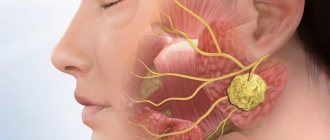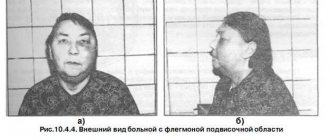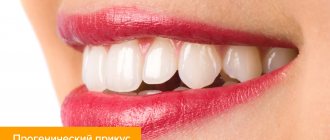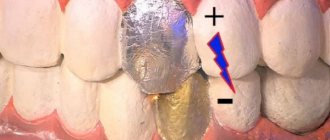An important and least constant parameter of homeostasis is the acid-base balance in the oral cavity. The most informative indicator of acid-base balance is the pH value. This indicator varies depending on the area of the cavity: the pH value is acidic in the interdental spaces and neutral or slightly alkaline at the tip of the tongue. An integral indicator of acid homeostasis in the oral cavity is the pH of saliva. Normally, the pH of saliva is in the range of 6.5-7.5.
Changes in the acid-base balance in the oral cavity can be of two types: acidosis or alkalosis. In any direction of shifts in homeostasis, physiological and pathological changes should be distinguished. Physiological changes are short-term, do not lead to disruption of normal physiological processes and do not affect the structure and function of oral tissues. Pathological changes significantly exceed the boundaries of the norm and lead to disturbances in the structure and functions of certain tissues of the oral cavity: caries, desquamation of the mucosal epithelium, tartar deposition, periodontitis.
Basic mechanisms for regulating the acid-base state in the oral cavity.
Saliva is the main fluid of the oral cavity, in addition, gingival and tissue fluid is constantly secreted here, diffusing through the mucous membrane.
The secretion of saliva in the glands goes through two stages. First, a primary isotonic secretion is formed in the acini of the salivary glands, the composition and properties of which are determined by passive ion transport and the action of electrophysiological mechanisms. Then, in the ducts of the glands, control and correction of the primary secretion is carried out depending on its composition and physiological need. This affects the acid-base properties of secreted saliva (Fig. 10.5).
Rice. 10.4. Scheme of the main interactions in the system of regulation of the acid-base state of the oral cavity
Salivary gland secretion pH 7.2
Rice. 10.5. The ion transport system in the tubules of the salivary glands, affecting the acid-base composition of saliva. ICP - interstitial duct cells
Interstitial cells of the duct are involved in the formation of the blood-salivar barrier, first described by Yu.A. Petrovich, which has high selectivity to ions. Excess hydrogen ions along with sodium ions from the gland duct enter the blood through passive reabsorption, which leads to a decrease in the acidity of saliva. And HCO3 ions from blood serum and tissue fluid selectively enter saliva through active transport, increasing its alkalinity. Due to this mechanism of regulation, the pH of secreted saliva can differ noticeably (by tenths of pH) from the always stable blood pH of 7.4. Mixed saliva is the main regulator of CBS in the oral cavity. The implementation of the functions of saliva significantly depends on the rate of its secretion, the amount in the oral cavity and rheological properties (viscosity, surface tension).
Ph meter
This device allows you to measure acidity at home. It is believed that it does not have high accuracy, but it is inexpensive and convenient to use. The cost of a Ph meter depends on its characteristics. In particular, you should pay attention to the measurement range - from 0.00 to 14.00. In addition, indicators such as operating temperature, device division value, and accuracy are important. When purchasing, it is worth considering that the device must be calibrated.
What is the sequence of steps to determine the acidity of saliva, urine, blood or other liquids at home using a Ph meter:
- it is necessary to remove the protective cap at the bottom of the device body;
- turn on the device (move the slider to the right);
- immerse the Ph-meter up to the grooved mark in the liquid whose acidity is to be tested (in this case, in mixed saliva);
- read the readings after they have stabilized.
After each measurement, it is necessary to thoroughly rinse the electrode of the device with distilled water. As soon as the manipulations are completed, wipe the device dry with a napkin and put on the protective cap.
Important! To obtain reliable data, it is recommended to measure the acidity of saliva at least 5–8 times a day.
Interaction between microbial plaque and oral fluid.
Interactions occurring in the plaque-oral fluid system are the most frequent, rapid and pronounced. Microbial plaque is a strong factor in the destabilization of CBS in oral fluid. A change in the CBS in the oral fluid can occur either in the direction of acidosis or alkalosis (Fig. 10.6). Acidosis develops in dental plaque extremely quickly due to the predominance of acidogenic microflora, mainly streptococci, which ferment simple carbohydrates. Therefore, from the first minutes of eating sweet food, the concentration of hydrogen ions in dental plaque increases like an avalanche.
Rice. 10.6. Scheme of the main interactions in the “dental plaque – oral fluid” system in typical CBS disorders
The same buffer systems operate in the thickness of dental plaque as in saliva. However, due to the low diffuse properties of plaque, their effect is practically reduced to zero. Acids are washed away by oral fluid, the reaction of which (taking into account the buffer properties) changes in the acidic direction. The demineralizing properties of mixed saliva increase, and at a pH below critical (6.2 -6.0), it completely loses its mineralizing properties. At the same time, the microflora from saliva takes hydrogen phosphate ions, which they use in phosphorylation reactions that require energy.
Prolonged or frequently repeated acidosis on the surface of tooth enamel leads to its demineralization and the development of caries. This process is most likely in places where acidogenic microflora constantly accumulates (fissures and pits, cervical area and contact surfaces of teeth). In this case, tooth enamel begins to act as a kind of buffer system, taking part in the binding of hydrogen ions and, consequently, in reducing acidosis in the oral cavity. Therefore, the high activity of the carious process can be considered as the result of long-term decompensation of adaptive reactions aimed at combating acidosis in the oral cavity.
Alkalosis in dental plaque and oral fluid does not develop as quickly as acidosis, but nevertheless, changes in the reaction towards the alkaline side can be very pronounced. The main source of bases in dental plaque and oral fluid is urea. Some microorganisms of dental and lingual plaque (mainly periodontopathogenic) utilize urea, which is a substrate for the formation of ammonia using the enzyme urease. The conversion of accumulated ammonia into ammonium cation is the cause of alkalosis. Urea can enter the oral fluid in several ways; with food, secretions of the salivary glands (nitrates and nitrites), with gingival fluid, with blood plasma in case of bleeding of the gums and mucous membrane, as well as from decayed tissues. Urea can also be synthesized by microflora from amino acids contained in gingival fluid, dental plaque and mixed saliva (L-arginine).
An important result of alkalosis in oral fluid and dental plaque is its mineralization, leading to the formation of tartar, which is also facilitated by an increase in the secretion of gingival fluid. It occurs in more than 80% of people. The process of stone formation under conditions of alkalosis is accompanied by an increase in the concentration of electrolytes in the oral fluid (Ca2+, HPO42-, Cl-, K4, Mg2+ ions, etc.), insufficient synthesis of protective proteins and disruption of their structure. Tartar becomes an additional buffer system in the oral cavity, formed under conditions of prolonged decompensation of the body's adaptive reactions aimed at combating alkalosis. Tartar formation reduces alkalosis in the oral cavity by binding hydrogen phosphate ions and hydroxyl ions.
Thus, decompensated disturbances in the system of interaction between “dental plaque and oral fluid” are an important cause of the development of the most common dental and periodontal diseases. Demineralization of enamel in case of acidosis leads to the development of dental caries. Stone formation in the case of alkalosis, along with other factors (largely also dependent on local alkalosis), contributes to the aggravation of the inflammatory reaction in periodontal tissues.
In addition to dental plaque, plaque on the tongue has a pronounced effect on CBS in the oral cavity. Its microflora, which includes a large proportion of anaerobic microorganisms, takes part in the formation of dental plaque, as well as acids and bases in mixed saliva, and has a suppressive effect on acidogenic microflora. The muscular system of the maxillofacial region and oral cavity is an important factor in the regulation of CBS. Chewing, motility of the lips and cheeks contribute to more intense salivation, active excursion of oral fluid, and removal of food debris. In this regard, language plays a special role. It not only participates in the formation of the food bolus and self-cleaning of the oral cavity. The tip of the tongue is a mechanical regulator of the CBS, especially in the area of the oral and occlusal surfaces of the teeth. Being one of the “cleanest” areas in the oral cavity, almost devoid of microbial plaque, the tip of the tongue distributes saliva in the mouth, moves it and thereby accelerates ion exchange processes. Muscle contractions associated with chewing, swallowing and speaking help empty the salivary glands.
Methods for assessing the acid-base status in the oral cavity.
Assessing CBS in the oral cavity provides the dentist with useful information for early diagnosis, prognosis, treatment monitoring and prevention of major dental diseases. It allows you to choose methods of pathogenetic treatment, carry out competent and adequate correction of nutrition, habits, hygiene, and, if necessary, plan orthopedic and orthodontic treatment, surgical interventions.
Various indicators can be used to assess CBS in the oral cavity. The potentiometric method is accurate, fast and affordable, for which laboratory pH meters with dial or digital display are used, equipped with a measuring electrode sensitive to hydrogen ions and an auxiliary reference electrode with a stable electrical potential.
Determination of the pH of saliva or a suspension of microbial plaque is carried out using standard glass electrodes. In this case, the liquid to be tested is placed in a small cuvette. To determine pH directly in the mouth, metal oxide measuring electrodes made of antimony or special olives in which the measuring and reference electrodes are sealed are more convenient. There is a radiometric method for determining pH in the mouth (from a distance).
The pH value of oral fluid in the same individuals without any stimulation is constant. During the day, regular temporary fluctuations in the pH of saliva occur: in the morning it is lower than in the middle of the day, and tends to increase in the evening. At night, the pH of mixed saliva is lower than during the day. Along with the daily rhythm of changes in the pH of the oral fluid, a decrease in its values with age was noted. A decrease in pH is observed in women during pregnancy. In different parts of the oral cavity, the pH value is different: on the mucous membrane of the hard palate the reaction is 0.7-1.2 units. more alkaline than in other areas; in the area of the lower lip it is 0.3 -0.8 units. more alkaline than in the upper region.
In 1940, the American dentist R. Stefan, after applying solutions of glucose and sucrose to the teeth, observed a rapid decrease in pH in dental plaque, followed by a slower return to the original level. This change in pH of plaque or mixed saliva as a result of microbial glycolysis of sugars is called the Stefan curve (Fig. 10.7). V. A. Rumyantsev identifies the following informative calculated indicators in this curve: amplitude of the Stefan pH curve
catacrotic slope
anacrotic slope
asymmetry coefficient
intensity of critical pH decrease
Rice. 10.7. Curve (Stefan curve) of changes in the pH of mixed saliva after consuming sucrose (C): pH1 - initial pH value; A is the amplitude of the curve; Tk — duration of catacrota; Ta—duration of anacrota; рНк—critical pH value; S is the intensity of the critical pH value; pHm - minimum pH value
The amplitude of the curve is the most informative indicator, since it characterizes the acid-producing activity of the oral microflora and the effectiveness of the mechanisms regulating CBS. The greater the amplitude of the curve, the more organic acids (mainly lactate) are produced in response to carbohydrate stimulation of the microflora and the less ability the CBS regulation systems have to eliminate acidosis. The value of the catacrotic coefficient increases with the increase in the rate of microbial acid production and, to a greater extent than the amplitude, characterizes its acidogenic activity. The anacrotic coefficient, on the contrary, indicates the ability of the CBS regulation systems to restore homeostasis.
Using the asymmetry coefficient, one can judge the degree of destabilizing effect of carbohydrate-containing products on WWTP. The intensity of the critical decrease in pH characterizes the severity of exorbitant changes in the CBS, which can lead to the development of pathology (demineralization of hard dental tissues). The listed indicators of the Stefan curve reflect short-term impairments of CBS in the oral cavity. J. Nikifruk provides data that the daily intensity of the critical decrease in pH in dental plaque is several times greater in caries-susceptible individuals compared to caries-resistant individuals.
The use of a test carbohydrate-containing product (identical in composition, concentration and time of application) as a stimulator of acidogenic oral microflora made it possible to use the Stefan curve to evaluate the suppressive effect of various agents on the microflora. Comparison of the amplitudes of pH test curves in oral fluid before and after the use of antimicrobial agents allows one to assess the degree and duration of their suppressive effect, as well as compare the effectiveness of different concentrations, fillers (solvents), and duration of use. The method also turned out to be useful in assessing the effectiveness of oral hygiene products and the effect of food products on CBS in the mouth.
Measurement methods
Litmus paper is a tool that allows you to determine the pH of saliva in the mouth both in the laboratory and at home. Such test strips can change color in the presence of alkalis and acids. The environment, accordingly, can be neutral, alkaline, acidic.
Important! Using litmus strips is very simple - just dip the strip in the desired solution for 2-3 seconds and compare the resulting shade with the scale.
How to use a litmus test strip should be read in the instructions
An acidic environment is considered when Ph is less, alkaline - more than 7. Indicator paper can have different forms, sold in the form of strips, boxes, rolls, pencil cases, tubes. It is noteworthy that universal litmus strips are used exclusively for determining Ph values over a wide range (accuracy - up to 1 unit or tenth).










